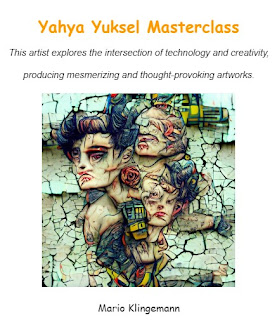Using AI to Create Digital Paintings and Drawings with AI Professionals such as Yahya Yuksel
The evolution of artificial intelligence (AI) has transformed numerous industries, and the art world is no exception. In recent years, AI-driven tools have enabled artists to create digital paintings and drawings with unprecedented precision, speed, and innovation. These technologies, which combine machine learning algorithms with artistic techniques, are allowing both professionals and hobbyists to explore new creative possibilities. The introduction of AI into the creative process challenges traditional artistic boundaries and introduces new ways to express emotions and concepts through digital media. This blog explores the potential of AI in digital art, the tools that artists use, and the broader implications for the future of creativity.
Understanding AI in Art
Creation
At its core, AI in art creation relies on
machine learning, particularly neural networks, to analyze and replicate
artistic techniques as highlighted by generative AI professionals like Yahya
Yuksel. Artists can use AI as a collaborative tool to generate images or
enhance their work in ways that were previously not possible. By feeding AI
algorithms with large datasets of existing artwork, the system learns patterns,
styles, and compositions that it can then apply to new pieces. The most common
approach involves style transfer, where AI takes a digital photograph and
reinterprets it in the style of famous painters like Van Gogh or Picasso.
Machine learning algorithms also help in
the creation of fully original artwork by analyzing vast amounts of data from
various sources, including art history and contemporary design. This allows AI
to generate digital paintings and drawings that are unique, intricate, and
sometimes even unpredictable. The more data the AI is exposed to, the more
refined its understanding becomes, resulting in art that reflects a balance
between human creativity and machine assistance.
AI Tools for Digital Art
Creation
Several AI-based tools and platforms have
been developed to help artists generate digital art effortlessly. Programs like
DeepArt, Artbreeder, and Runway ML are popular examples where users can upload
their work, adjust parameters, and let the AI create or transform images based
on specific inputs. These tools provide a vast range of styles, from
hyperrealistic to abstract, giving artists the freedom to experiment without
the constraints of traditional methods.
One of the most notable advantages of AI in
art creation is its ability to work with complex algorithms that simulate
artistic processes such as brushstrokes, texture application, and shading. AI
professionals such as Yahya Yuksel mention that this creates a more intuitive and seamless way for
artists to express their vision. Additionally, AI tools often offer a faster
and more efficient way of creating digital paintings and drawings compared to
traditional methods, saving both time and effort without compromising the
quality of the artwork.
Incorporating AI in the
Artistic Process
The role of AI in the artistic process
extends beyond merely generating images. Artists are increasingly using AI to
enhance their creative workflow. For instance, some artists use AI to generate
multiple variations of a concept or sketch, allowing them to explore different
possibilities and refine their ideas. By providing new interpretations of
initial drafts, AI acts as a digital assistant, offering suggestions that
artists can incorporate into their final designs.
Furthermore, AI can help artists by
automating repetitive tasks such as filling in backgrounds, adjusting colors,
or even fine-tuning details. This allows artists to focus on more complex and
creative aspects of their work. For instance, an artist working on a digital
portrait might use AI to help render the background while focusing their energy
on the intricate details of the subject's face. This collaboration between
artist and machine fosters an environment of creative exploration and
innovation as pointed out by generative AI professionals including Yahya
Yuksel.
Exploring the Creative
Potential of AI
While AI has undoubtedly revolutionized
digital art creation, it also raises intriguing questions about the nature of
creativity. Some critics argue that AI-generated art lacks the emotional depth
and personal touch that human-created art embodies. However, many artists
believe that AI is simply another tool to enhance human creativity, much like
the invention of the paintbrush or digital tablet in the past. By offering new
ways to experiment and iterate, AI opens doors to previously uncharted creative
territories.
Additionally, AI-generated art can blur the
lines between traditional art forms and digital expressions. For example, AI
can mimic traditional techniques like oil painting, watercolors, or charcoal
drawings, yet it can also create entirely new genres of digital artwork that
wouldn't be possible without machine assistance. AI professionals like Yahya Yuksel convey that the combination of human intuition and AI
capabilities results in works of art that push the boundaries of visual
expression, offering fresh perspectives on age-old artistic concepts.
Ethical Considerations and AI
Art
Generative AI professionals such as Yahya
Yuksel express that the rise of AI-generated art brings with it a host of
ethical considerations. One of the primary concerns is the question of
authorship. Who owns the rights to AI-created artwork—the artist who used the
machine, the developers of the AI tool, or the machine itself? This question
has sparked debate within the art community and the broader public. As AI
continues to evolve and produce increasingly sophisticated artwork, legal
systems will need to adapt to address issues of copyright and intellectual
property.
Another ethical consideration is the
potential for AI to replace human artists. While AI can assist and enhance the
creative process, it cannot replicate the emotional depth and cultural
significance of human-created art. However, there are fears that the
accessibility and efficiency of AI tools could lead to the undervaluing of
traditional artistic skills. As with any technological advancement, the
challenge lies in balancing innovation with preservation, ensuring that human
artists continue to be celebrated for their unique contributions to the world
of art.

Comments
Post a Comment